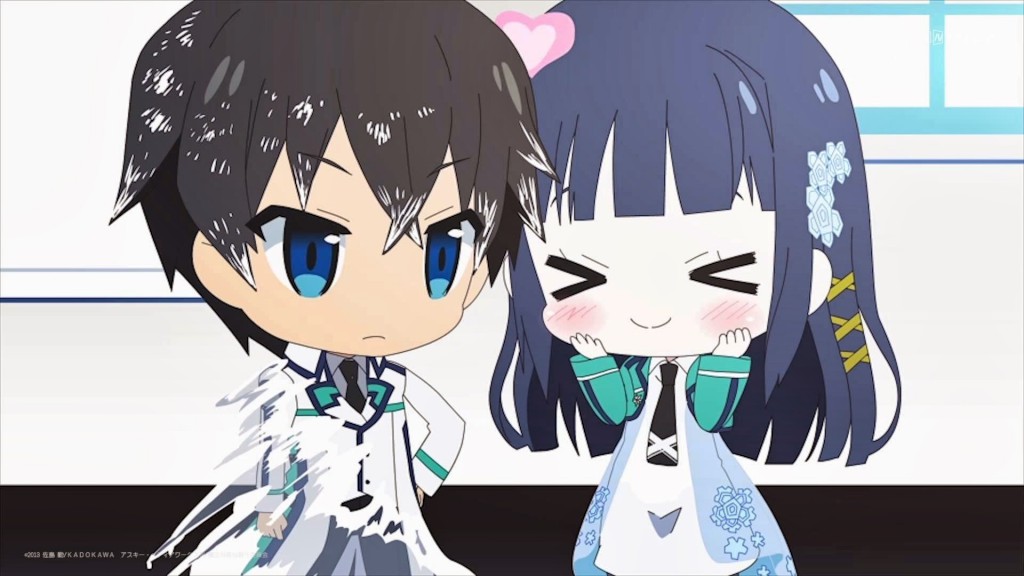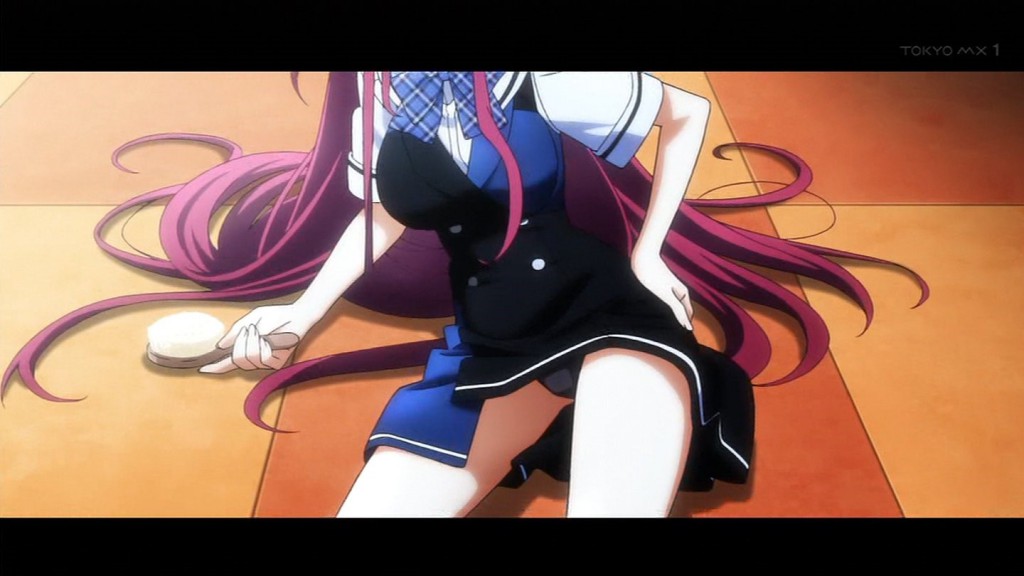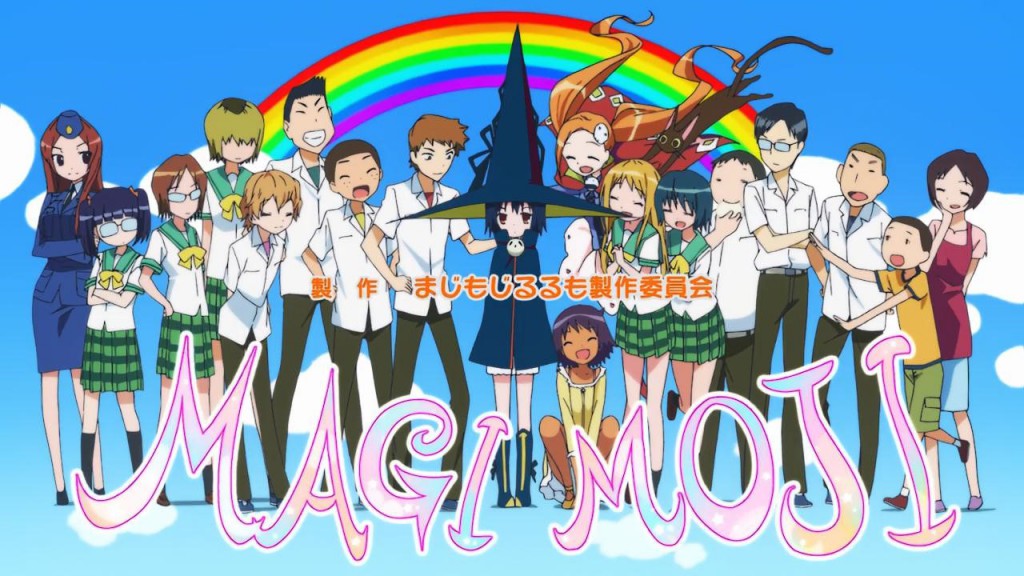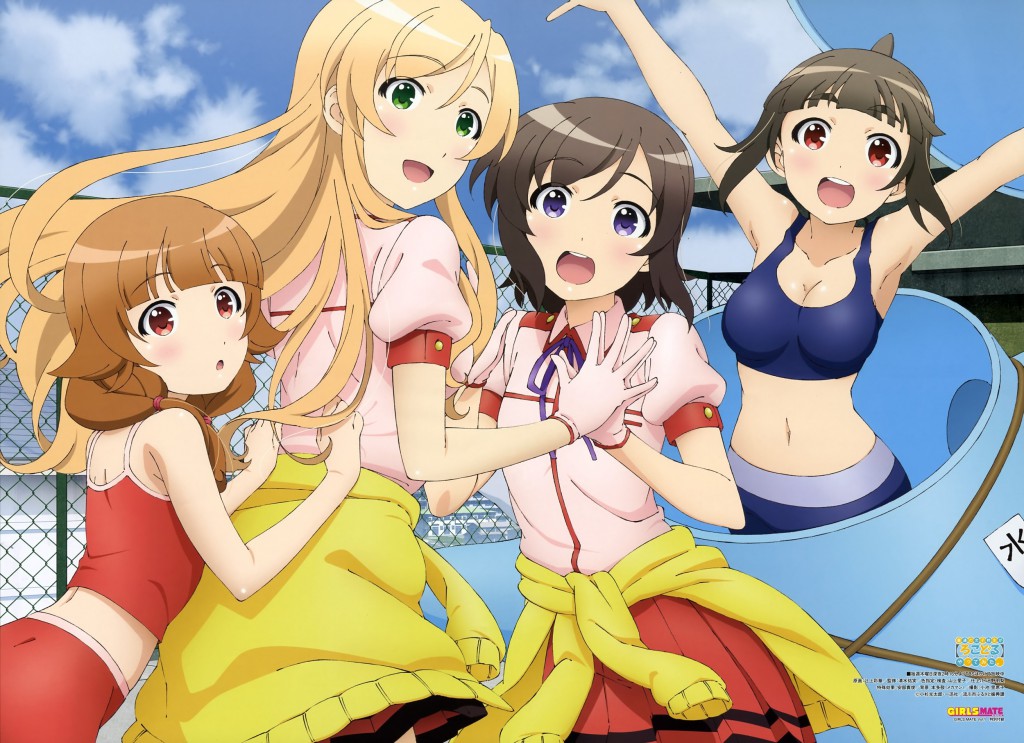August 16th, 2015 in Anime, Chaika the Coffin Princess OVA, General Reviews by The Droid

So, with the conclusion of the second (and potentially, final) season of “Chaika, the Coffin Princess”, it is now time to trot out the OVA, so we can tell a story that otherwise would not have fit into the full run of things. The OVA is actually two half-episodes, where the Red Squad and the White Squad come into contact with one another while avoiding the Kliemann Agency (more or less), but this is done more to be goofy than any real import, much like “Darker Than Black” Episode #26, which was goofy and silly and funny and completely out of character with the show’s original dark and dismal run.
In this outing, the guys and gals are still looking for the parts of dismembered Daddy and come to a location to hunt them down, not knowing the other team is there. The tone here is far lighter, as they have to work together to escape the situation they are in, but it is not done as dramatic or intense as seen in the series; more like a minor inconvenience or annoyance, like bees living in your head. And when Akari has to flatten David twice for doing the same perceived pervy thing twice, well, it’s all for giggles and laughs. (more…)
Tags: Action, Adventure, Comedy, Fantasy, Romance, Shounen
August 14th, 2015 in The Irregular at Magic High School by The Droid

This is part of a wave of ‘informational OVA’, but it is helpful, in that it does explain things a bit better than the show did (or didn’t). “The Irregular at Magic High School” does have a full review, so you can give that an eyeball to see what that’s about. The OVA is very helpful for us, as it explains how things work within the framework of this show, but it is best seen between the first and second acts (after Episode Seven), as it not only clarifies what you have seen, it also sets up better what you will see in the School Competition Arc.
It is, again, done in this extreme Chibi style, and the hosts shift from segment to segment as they explain how their world operates, from how the divisions of class are determined, to how their magic works, to the tournament ahead and what one can expect. I chose for you the best time to view it, as you not only know who everyone is by this point, a lot of what they are saying now will make better sense, as you’ve seen it in action. If you watch it too early, you will be confused; if you watch it too late, it will be of no use, unless you are a huge OVA fanatic. It does sometimes come off as too cutesy (especially when (more…)
Tags: Comedy, Magic
August 9th, 2015 in Anime, General Reviews, The Fruit of Grisaia OVA by The Droid

The OVA for “The Fruit of Grisaia” (or “The Gray-Colored Fruit”) is designed to keep you interested in the show, as a movie (in theory) comes out in April and a new series follows shortly thereafter, but they come off as more unrestricted ecchi. All of the ladies seem to want to do the Wild Thing with Yūji Kazami, but it is done more for our benefit as the viewer than for anything that Yuri might want, or that the ladies are seeking.
I do not need to see a woman, dressed as a Playboy Bunny, riding a giant carrot like Slim Pickens did with that nuke in “Dr. Strangelove” or some girl who gives Yuri a real scrub down in the bath, washing everything including his shower nozzle. No, that’s not a euphemism; she really washes down the shower nozzle. Look, it just might be better for you to watch the shows (they run about six or so minutes each) to understand why they do what they do, as it does not make a lick of real sense, either as an OVA or in the general run of the show. And to make matters worse, it comes off as a painful obligation to do these histrionics, rather than a blossoming girl, experiencing the pangs of first love and true romance and….oh, just take off your clothes. Or, as seen above, a tantalizing glimpse of panties. (more…)
Tags: Drama, Harem, Psychological, Romance, School
August 6th, 2015 in Anime, General Reviews, High School DxD by The Droid

For those of you who have been following this show, “High School DxD” has two big things going for it….the left one and the right one! I place this show in the crowd with other boson-heavy offerings like “Sekerei”, “High School of the Dead”, Ikki Tousen” and “Maken-Ki” (to name but a few) and the OVAs now push it to the maximum, straining the limits of everything as much as Rias’ blouse is strained by her….achievements.
The OVAs are nothing more than to offer window-fogging reasons to glom onto unfettered bosoms. The shows are being done for two reasons: (a) a story like this in the regular run of episodes would impair the show’s ability to promote the main plot line and (b) to highlight the coming of the third season of the show (which will probably be concluded by the time this review hits the street). (more…)
Tags: Comedy, Demons, Ecchi, Romance, School
August 2nd, 2015 in Anime, General Reviews, OniAi by The Droid

I have notice the sheer amount of OVAs out there, as of late. It used to be that an OVA came out when there was a tale or two to tell that would not or could not fit into the standard run of things (like “Darker Than Black” #26) or you wanted to do something really goofy with things (Attack on Titan’s “Monster Character Theater”) or you were using it as a bridge to a new season of a show (“To Love-Ru”). But I am noticing that almost every show is trotting something out, so I guess this will be as big a part of anime as fan service (and if the OVA IS fan service, well…………..)
Now, I have done a full review of “OniAi” (Onī-chan dakedo Ai sae Areba Kankei Nai yo ne! “As Long as There’s Love, It Doesn’t Matter If He Is My Brother, Right”), but I was a bit surprised to see this OVA come out, as the series concluded over two years ago. It is a five short-run series (about five or so minutes each) and done in this extreme Chibi style. And the plot? What have I told you about using the words ‘plot’ and ‘OVA’ in the same sentence? These are merely an exercise to get your inner ecchi on, but it’s not all that pervy, as we do it in this style, so things lack a sense of ‘realism’. (more…)
Tags: Comedy, Ecchi
July 26th, 2015 in Anime, General Reviews, Magimoji Rurumo by The Droid

This is a kind of a magical girl show, but “Magimoji Rurumo” (or “Magi Moji Rurumo”) does not follow the same arc as others of this genre. It all starts at school (as does a huge amount of animes and mangas).
Kota Shibaki (that’s him on her right) is a high-school boy whose only interest is girls, but he is so openly perverted about it, the ladies avoid him. Well, he IS kinda icky. One day, he finds a book in the library about how to summon witches. (I don’t remember my library having books like this. Sure, maybe a science book talking about the just-launched Sputnik satellite, but we can’t ever be up to date on things.)
He tries it as a joke, but it turns out to be the real thing: an apprentice witch named Rurumo appears, to grant him a wish. Shibaki helps Rurumo and she, in return, refuses to take his soul. Well, that’s the nature of contracts with witches. Time passes and Shibaki wishes he could see Rurumo again. His wish is granted immediately as Rurumo falls from the sky and crash-lands in front of him. Well, a lot has happened. He finds out that as punishment for Rurumo not taking his soul, she’s been busted down to an apprentice demon. (more…)
Tags: Comedy, Ecchi, Fantasy, Magic, School, Shounen
July 24th, 2015 in Anime, General Reviews, Locodol by The Droid

This is a show with a rather capacious title. It is referred to as “Locodol”, short for “Futsū no Joshikōsei ga Locodol Yattemita” or “Normal High School Girls Tried Being Locodols”. OK, a Locodol stands for “Local Idol”, which would be a person (a girl, in this case), who is a city-wide idol or regional-wide idol and not someone nationally known.
In the town of Nagarekawa, Nanako Usami, (second from right), a normal high school girl, is approached by her uncle to become that “Locodol”, partnering with upper-classmate normal high school girl Yukari Kohinata, (second from left) to form the idol unit, Nagarekawa Girls. As the girls use their talent to promote the city of Nagarekawa and their businesses, they are joined by normal high school girl Yui Mikoze, (far right; she wears a costume of Uogokoro-kun) and other normal high school girl Mirai Nazukari, (far left) who serves as Yui’s substitute. (more…)
Tags: Comedy, Seinen
July 19th, 2015 in Anime, General Reviews, Sunday Without God by The Droid

I usually do not like post-apocalyptic shows, as it always presents the fall and demise of society; however “Sunday Without God” certainly goes in a different direction than you surmise. But there is a big problem with the logic and physics of this dying world we find ourselves in.
It is the future. Fifteen years earlier, God abandoned the world, but initially, didn’t tell anyone. The world made two discoveries: no one was dying and no one was being born. God later came down to say that Heaven was overcrowded (What? Really? And God couldn’t do anything about it?) and that there would be no new admittances and that we were on our own. But it’s like “Death Becomes Her”, in that you have to take care of your body. You can still die, but you just kind of hang around as your body rots away.
In this village of no given name, we find 12-year-old Ai Astin (dead center). Her mother was a gravekeeper, but since she was the last person who could really die and did so, Ai has taken over the position. She tends over the 134 graves in the village, ready for the day when she has to use them. A stranger comes into the town and proceeds to kill everyone, as he looks for this mysterious Hana. His name is Hampnie Hambart (to her right). Since she has no reason to stay in the village and he has places to go, they set out on a journey to try and find Hana and even to help Ai in her quest to save the world God has abandoned. (more…)
Tags: Fantasy, Mystery
July 16th, 2015 in Anime, General Reviews, Tamako Market by The Droid

Ah, young love. Is there anything more beautiful than young love? Well, maybe an ice-cold bottle of a long-necked Teutonic brew on a painfully hot day, but that’s just me. And I haven’t had young love in a long time. I remember, in my youth, when I was young and a youth and….ahem! Back to the review of “Tamako Market”.
Tamako Kitashirakawa (second from left) is the eldest daughter of a family who runs a mochi shop in the Usagiyama Shopping District. One day, Tamako encounters a strange talking bird named Dera Mochimazzi (I assume you can find that one) who comes from a distant land, searching for a bride for his country’s prince. After becoming overweight from eating too much mochi (a bird who’s a pig?), Dera ends up becoming a freeloader in Tamako’s home. The series follows the everyday life of Tamako, her friends, family and neighbors, and this peculiar bird. (more…)
Tags: Comedy, Slice of Life
June 25th, 2015 in Ookami Shoujo to Kuro Ouji by The Droid

As I mentioned earlier, there has been a lot of romantic comedies coming out. This one “Wolf Girl and Black Prince” (“Ōkami Shōjo to Kuro Ōji”) is an interesting take on things in the realm of high school love.
The story centers around Erika Shinohara, a 16-year-old girl who tells her friends about her romantic exploits, but she actually has no boyfriend. Well, you had best produce, so she claims that the handsome boy in a candid photo on her phone is her boyfriend, but it turns out that boy is a schoolmate named Kyōya Sata. She has no choice but to make him her fake boyfriend. Unfortunately, Sata may look like a sweet person, but he is actually an ultra-black-hearted sadist. Sata takes advantage of Erika’s weakness and treats her like his dog.
And, I mean, he is really mean. He doesn’t exploit her or really blackmails her, but he is as cold as they come and Erika feels trapped into this all. This is where some of my resentment crops up. A couple of opportunities arise that she could dump him and just write it off as ‘things didn’t work out.’ It also brings up the second question: what if her two friends, Marin Tachibana and Aki Tezuka, are also faking it and they really don’t have boyfriends? Just a thought. (more…)
Tags: Comedy, Romance, School, Shoujo









